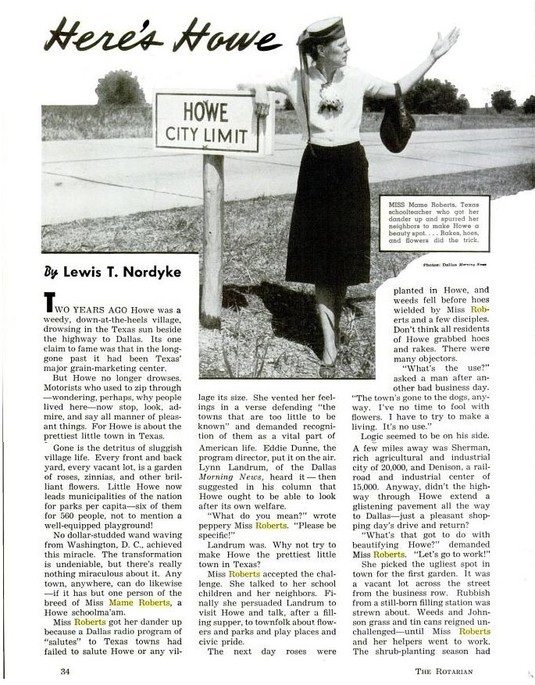Mame Roberts Historical Marker
Introduction
Text-to-speech Audio
Images
Mame Roberts' promotional poster for Howe, Texas beautification

Backstory and Context
Text-to-speech Audio
Mame Roberts was born on August 19, 1883, in Howe, Texas to James and Martha Sue Roberts. Mame Roberts lived her entire life in or near the community of Howe. Mostly self-taught and highly educated, she worked as a substitute teacher in the lower grades at the Howe Public Schools in the early 1900s. She left her work as an educator to devote her attention to promoting civic improvements and beautification.1
As a writer of a weekly column in the Howe Messenger, Mame Roberts promoted her hometown and encouraged its beautification. She launched a campaign to make Howe the “prettiest little town in Texas”, and it motivated other small towns throughout the state to take similar action toward beautification. A series of articles in the Dallas Morning News provided step-by-step instructions on how to carry out these beautification efforts. Roberts came into great demand as a speaker at garden club gatherings throughout her part of Texas. Her work also attracted the attention of Life magazine and Reader’s Digest. On May 14, 1949, she was named “Woman of the Day” by Eleanor and Anna Roosevelt on their national radio program.2
Mame Roberts served in several leadership positions throughout the state of Texas. These included: president of the Grayson County Federation of Women’s Club; president of the Texoma Redbud Association, which urged the planting of redbuds along highways in Texas and Oklahoma; and founder and president of the Howe Sesame Club. Her work, which spanned the decades before and after World War II, is a significant part of the civic history of Howe and of all the towns that put her lessons of beautification into practice.3
Sources
2Mame Roberts Historical Marker. The Portal to Texas History. Accessed December 01, 2016. https://texashistory.unt.edu/ark:/67531/metapth256835/
3Mame Roberts Historical Marker. The Portal to Texas History. Accessed December 01, 2016. https://texashistory.unt.edu/ark:/67531/metapth256835/
